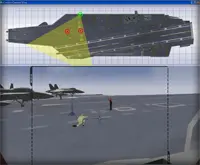Simulation and Visualization
 TA is especially expert at 3D representations and visualization of complex mechanical systems, physical phenomena, biochemical structures, and data sets. As a veteran of two Hollywood visual effects studios, Leonard White brings unique insight into physics-based simulations and calculations requiring a self-consistent 3D representation, including physical mechanisms for particle generation, solid body dynamics, and collision calculation. In addition, TA brings unique solid modeling expertise using SolidWorks, Maya, and other rendering applications.
TA is especially expert at 3D representations and visualization of complex mechanical systems, physical phenomena, biochemical structures, and data sets. As a veteran of two Hollywood visual effects studios, Leonard White brings unique insight into physics-based simulations and calculations requiring a self-consistent 3D representation, including physical mechanisms for particle generation, solid body dynamics, and collision calculation. In addition, TA brings unique solid modeling expertise using SolidWorks, Maya, and other rendering applications.
In this area, TA is actively creating a real-time ocean wave visualizer for the US Navy (ONR Contract #N00014-07-M-0437). The overall goal of the continuing SBIR program is to produce a computer-based system for accurately simulating and visualizing near-shore waves for use by mission planners and as a training aid. As part of the ongoing program, the ability to produce photo-realistic animations and images of ocean waves has been demonstrated. This technology has also been used for visualization of wave scenarios for Woods Hole Oceanographic Institute.
TA is involved in real-time graphical simulation as well, including development within commercial physics “game” engines. TA has developed a real-time 3D visualizer accurately representing an aircraft carrier flight deck to support camera location and guidance programs for the Navy. TA has worked with several engines including the open-source Blender 3D engine, and the Unreal engine developed by Epic Games (The Unreal engine has been the target of military simulation integration efforts). These efforts include basic geometry and scenario manipulation (using the COTS editors available with these engines) as well as incorporating new capabilities into the engines using the supported scripting languages. Real-time systems make use of parallel processing on GPU’s, and TA is well versed in the use of OpenGL, CUDA and other GPU tools. Also in the area of stand-alone software tools, TA is in the process of developing advanced tools for optimal geometric packing calculations of aircraft in hanger bays for NAVAIR Lakehurst.
In the life sciences area, TA is applying state-of-the-art visualization and simulation capabilities to model and predict the behavior of proteins. This work has resulted in a continuing collaboration with biophysics groups at Northeastern University.
